Note: There is always an exception to every rule.
Overview
Road type designations in Waze should be determined by the physical layout and use of the road, not by the name of a road.
Road types do not affect naming. A dirt road that is a US Highway would still be named as “US Hwy #.” See Road Naming (USA)
Some road type classifications are influenced by city size, traffic density, and regional conventions. For example, in a very large city a primary street may have three or more lanes in each direction on a divided road. While in a town of dirt roads, the only paved single lane street could be a primary street.
While editing the maps, you may notice that some of the roads are not labeled properly. This means, the road type might be wrong (a highway is marked as a street) or that one road has a few road types (a highway is marked as Freeway, highway and primary at different segments).
The importance of proper labeling is in two aspects:
- When viewing the map, the 'bigger' roads should appear at the far zoom levels. Without proper labels, the 'zoomed out' display can be very confusing.
- When planning a route, major roads will get priority over smaller roads.
Before editing
Be sure that you are completely familiar with the articles on:
Starting Point
Naming conventions can be useful as starting point when determining a road type. Be aware that there are many regional naming variations. Remember that this is only guide on where to start when determining a road type.
Road Type Classifications:
Freeway 

Although it is currently listed under Highways, a freeway does not have to be a highway.
Freeways have strict classification rules.
- Almost all US Interstates are Freeways (exceptions Wikipedia Link)
- Multi-Lane, divided road (with rare exceptions Wikipedia link)
- No cross traffic.
- No stop lights (except for ramp meters).
- No stop signs.
- No parking.
- No stopping (except for toll booths, freeway access metering, movable briges Wikipedia link, and traffic congestion.)
- Highest speed limits. (relative to region)
- Some have minimum speed limits.
- Limited access
- Access restrictions vary by state but some typical restrictions are
- No pedestrians
- No bicycles
- No mopeds
- Entrance ramps are typically designed with an acceleration zone so that cars can accelerate up to freeway speeds before merging into freeway traffic.
- Exit ramps are typically designed with a deceleration zone so that traffic can exit the freeway at freeway speeds without obstructing traffic, then have sufficient distance to slow down before any turns.
- Access restrictions vary by state but some typical restrictions are
For information on how to best layout freeways and their junctions, please review the section on freeways in the Junction Style Guide
Highways

Highways are typically numbered or named roads that can be followed to get from one city to another. If the cities are in different states, it will likely be named as a US highway. If they are in the same state, it will likely be named as a State Highway. If they are in the same county, they may be named as a County Highway. There are two main Highway labels in Waze, Major and Minor. Their use may depend on regional population or traffic densities.
One differentiation between Major and Minor is the design and use of the road. A Major Highway is purpose built for the expedience of thru traffic. A Minor Highway could have a diverse range of priority placed on the flow of thru traffic.
- US Highways should typically have a Major Highway or Minor Highway road type.
- State Highways differ by region. In some states all State Highways deserve a Highway road type. In others the “State Highway” term is used very loosely, or every road in a town may have a state highway name. In those cases many state highways will not be a highway road type.
- County Highways vary greatly, some may deserve a highway designation.
Major Highway

Purposely built as a major throughway.
- Higher speeds. Speed limits should be near or equal to Interstate or Freeway speed limits in the same area. (typically within 5-10mph)
- Multiple lanes in each direction.
- Separated directions of travel.
- Turning traffic is typically limited to specified turn lanes or freeway style ramps to minimize obstructions to thru traffic.
- Partially limited access with few minor streets intersecting with this road. Intersections are most often with primary roads or other highways.
- Can have stoplights or freeway style interchanges.
- No stop signs
- Pedestrian crossings may be limited.
- Local business access is often restricted to frontage roads or other streets.
Typically roads with numerous side streets, parking lot accesses, residential driveways, low speed limits, undivided, or shared center turn lanes (suicide lanes) are not Major Highways.
Minor Highway

While still a labeled route that can be followed to get from one city/town/neighborhood to another, routing of thru traffic is not always a priority in the street design. Some minor highways are built with a higher priority on through traffic, while other minor highways are nothing more than a label dropped onto existing residential streets.
Minor Highways vary widely from large multi-lane roads with stoplights and higher speed limits, to small residential streets with stops signs.
Some minor highways may zigzag thru an area with many turns on local streets.
A Minor Highway thru the main street of a small town often retains focus on local access with pedestrian traffic and on street parking.
As a good note, remember that in major construction zones for Highways under construction, often Waze will try to route you through the construction, as if its the only route, since it prefers highways. When a user turns off the highway notation in their app, remember, it will STOP routing on "Minor Highways." So if you label a "Major Road" a "Minor Highway," it will be INCREDIBLY detrimental to the users directions.
Ramps
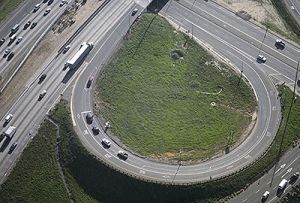

- All entrance or exits to freeways.
- A proper freeway style ramp onto or off of a Highway.
- Not for at grade street connectors.
- Not for turn lanes.
- Roads connecting a highway with a rest/service/parking area should be treated as ramps as well and named accordingly (e.g. "Exit to Service Area").
Information on how to lay out ramps and set the proper angles from the main road can be found in the Junction Style Guide.
Streets


Usually for local travel within a town.
Primary Street

Major roads or boulevards used to get across a neighborhood or city.
- Usually given higher priority for right of way with traffic controls.
- Primary streets may have less residential driveways.
- A town’s “Main Street,” if it is not a highway, is typically a primary street.
- In some regions “County Roads” are typically primary streets.
A primary designation is very relative to population and traffic densities. In the smallest rural town, a primary street may barely be wide enough for two cars heading opposite directions to pass each other. In dense urban areas primary streets may need to be a divided road with multiple lanes of traffic in each direction having traffic controls at every intersection.
Service Road

Also often known as a frontage road.
- A smaller street found running alongside a limited access highway or other primary street.
- Service roads allow local traffic to enter and exit driveways, parking lots, and intersecting streets without congesting thoroughfare traffic.
- (NOTE: Service Roads should NOT be confused with what is often called a "service alley". Service Roads will not prevent routing.)
Street

- Any road that traffic will be routed onto.
- At grade connectors & turn lanes when separated by enough distance from the streets that one is needed for proper GPS tracking.
Other
Dirt
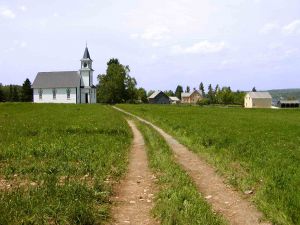
A road that is not paved.
Marking a road as "Dirt Road" will have the following consequences:
- Road name will not display in client.
- Routing will be restricted to avoid this road if user has disabled the use of dirt roads in client settings.
Parking Lot Road
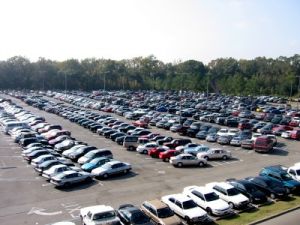
Parking lots, along with other publicly accessible roads such as alleys that should not be used for traffic routing unless directly at the start or end point of a route.
- Do not map the rows within parking lots because it clutters the map.
- Parking Lot roads have a transition penalty when exiting the Parking Lot road segment. This should prevent Waze from routing you through a Parking Lot as a shortcut.
- Use Parking Lot road type for all necessary segments in the Parking Lot.
- The proper use of parking lot roads can also help to avoid automated traffic jam reports as well as Map Problems related to Wazers driving in unmapped parking lots. Draw in the drivable portions of the parking lot that are near streets and other roadways. This will prevent the Waze routing server from assuming you must be on the main road when in fact you are stopped in the parking lot stopped.
Additional information on this topic can be reviewed in the forums.
Private Road
Private roads are useful for the following situations:
- Gated communities with controlled access
- Schools and Universities
- Military Bases
- Roads within apartment complexes and trailer parks
- Businesses with controlled access (gates / guard)
Private roads function in a similar way to Parking Lot roads using a transition penalty when leaving the Private Road. This transition penalty to keep Waze from incorrectly routing Wazers through a private area as a shortcut.
When mapping Private roads, all of the road segments within the Private area should be of the Private Road type. Private roads do not suppress automated traffic jams in the Waze application.
Non-drivable
Your car should not be here!
- These may be useful for points of reference when navigating such as seeing on a map where a turn is in relation to a railroad crossing.
- When Waze users travel on a non-vehicle route such as a bicyclist or mass-transit rider, marking these routes can be useful to explain the GPS traces that result.
- If a base map scan has non-drivable routes on it, it is important to mark these to prevent traffic routing onto them.
- Non-drivable routes should not have any type of junction with a drivable road. When crossing a drivable road, the non-drivable road should be bridged across without a junction between them and set at a different level.
Walking Trails
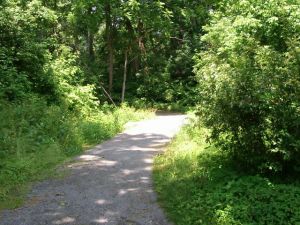
Also bike trails
Pedestrian Boardwalks

Stairway
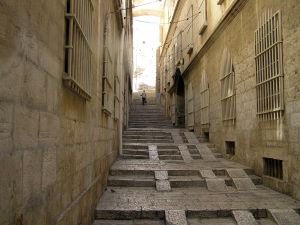
Railroad
Trains, Light Rail (does not appear in Waze client)
Runway/Taxiway
For aircraft at airports
Types of segments (Roundabouts) 

Roundabouts have few principals:
The first one, each node on the roundabout can only be connected to no more than one segment.
Each connection has a spectrum that exists in order to notify the Client on how to define the message (Go straight, exit through the 2nd / 3rd / 4th exit).

Each connection has a spectrum that exists in order to notify the Client on how to define the message (Go straight, exit through the 2nd / 3rd / 4th exit).
The system will include the radius border from the center and notify the user accordingly.
For more information on when to create a Roundabout or a loop instead, please review the Junction Style Guide.
Special case roads not covered
There are a number of other types of roadways and lane types which are not directly covered with the current options above. In some cases there are plans to add some of these special cases, but in the mean time the following guidelines are the best that can be done with the current settings.
Bus or cab only lanes
When a road or lane is designated for bus or cab use only, mark that road segment(s) as a Private Road to prevent the Waze router from using that segment(s) for general traffic, since the majority of the users will not be able to use that lane. It is also advisable to set the turn restrictions to prevent turns into that segment(s), but permit turns exiting the segment.
If a road is one-way, but allows bus or cab traffic to flow the other direction, leave the road as one-way with the normal flow of traffic. There is no need to create a second road traveling the opposite direction for the bus and cab-only traffic.
